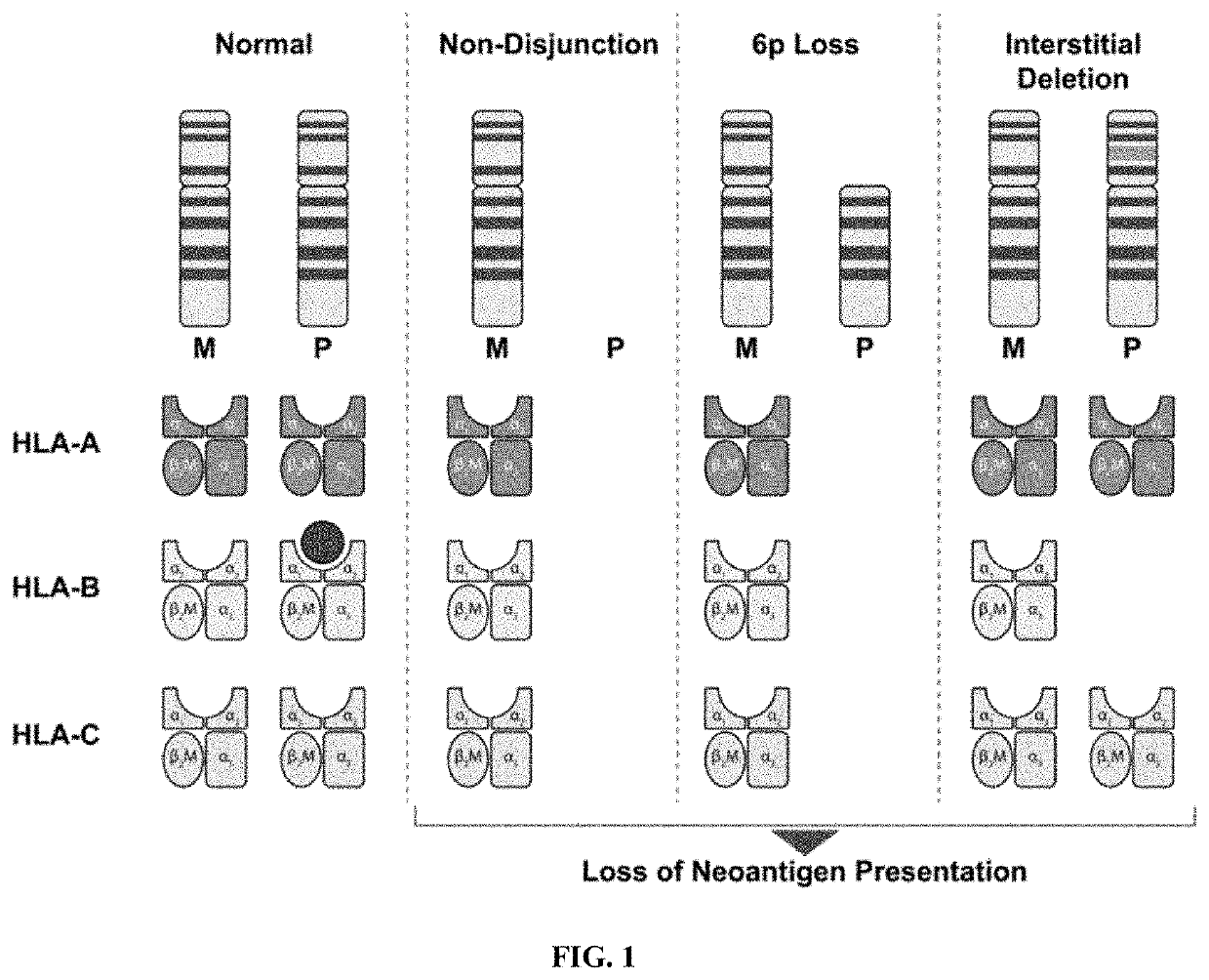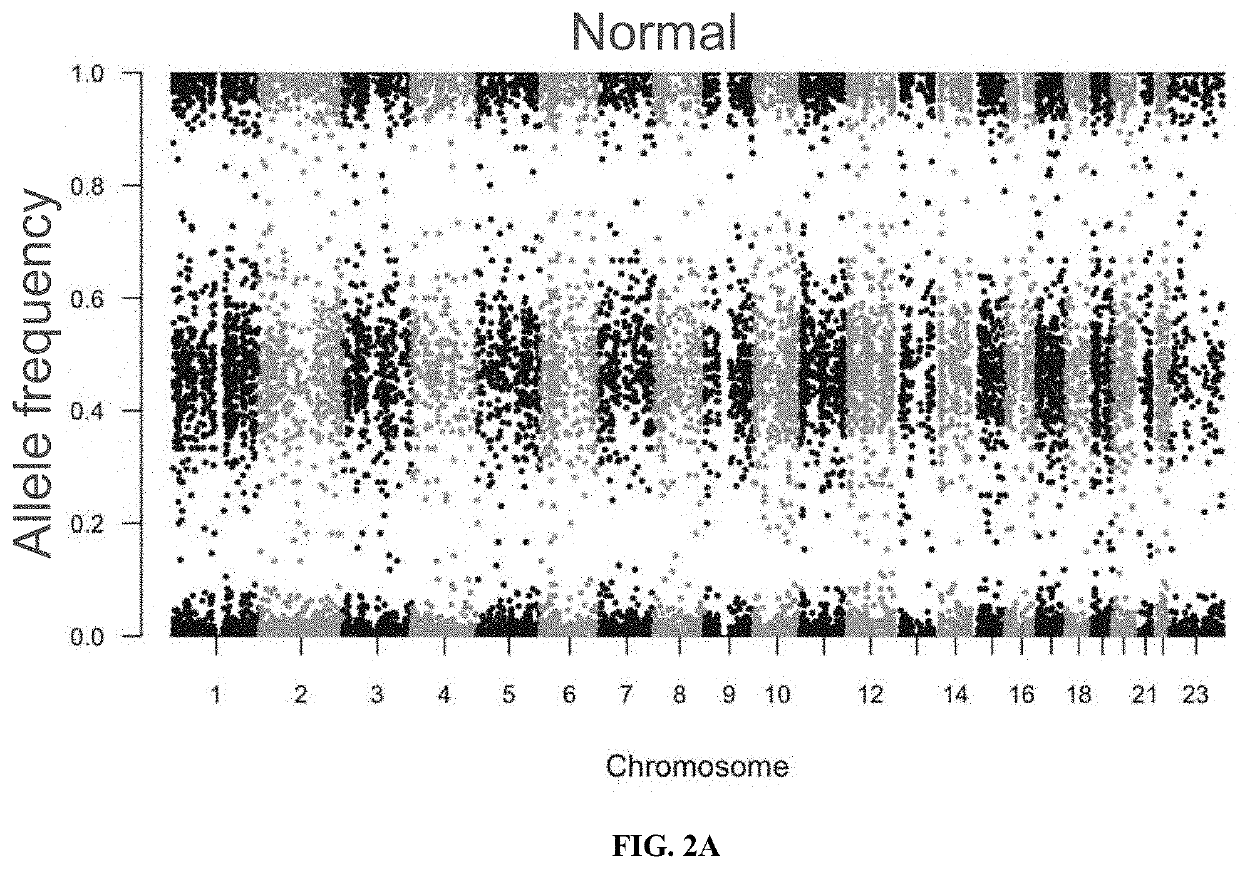Method of improving prediction of response for cancer patients treated with immunotherapy
a cancer patient and immunotherapy technology, applied in the field of cancer and immunotherapy, can solve the problems of poor outcome and poor outcome, and achieve the effects of improving the prediction of response, improving survival outcome, and reliably detecting loh
- Summary
- Abstract
- Description
- Claims
- Application Information
AI Technical Summary
Benefits of technology
Problems solved by technology
Method used
Image
Examples
example 1
[0133]This example describes training of an algorithm for analysis of TMB and LOH.
[0134]As described above (Materials and Methods), an algorithm was developed to determine LOH of the MHC Class I (LOH of MHC) using the PGDx Elio™ tissue complete assay, a tissue-based genomic profiling assay that targets >500 genes. A reference set to evaluate the accuracy of the algorithm was defined by sequencing and analyzing exome datasets from 226 non-small-cell lung cancer (NSCLC) formalin-fixed paraffin-embedded (FFPE) specimens and the corresponding matched normal sample (FIG. 2A and FIG. 2B).
[0135]The algorithm was initially trained using PGDx elio tissue complete for a subset of 20 of the 226 samples and then validated using the data associated with the remaining 206 samples.
[0136]The data show that LOH of chromosome 6 (MHC), 10, 12 (LOH of long arm only), 15 (B2M), 18, 19, and 21 was detected by the analysis of the allele frequency of polymorphic sites reported by the exome sequencing of tu...
example 2
[0137]This example describes correlation of LOH-MHC detection between WES and PGDx Elio™ tissue complete.
[0138]Agreement between predicted LOH of MHC as reported by PGDx Elio™ tissue complete and the observed LOH of MHC based on exome sequencing of the same sample is shown in Table 2 below.
TABLE 2Correlation of LOH MHC detection between WES and PGDxelio ™ tissue complete (206 samples).All Tumor PuritiesTumor Purity >35%Exome sequencingExome sequencingLOHNormalLOHNormalMHCMHCMHCMHCPGDx elioLOH488370tissueMHCcompleteNormal17133544MHCPPA (%; 95% CI)74% (61-84%)88% (74-96%)NPA (%; 95% CI)95% (89-98%)100% (92-100%)OPA (%; 95% CI)88%94%
[0139]PGDx Elio™ tissue complete had an overall agreement of 88% with the reference set of exome-based sequence analysis of 206 NSCLC samples in determining LOH of MHC (Table 2). When considering only samples with tumor purity higher than 35% (n=86) the overall agreement increased to 94%. PPA: positive percent agreement; NPA: negative percent agreement; OPA...
example 3
[0144]This example describes in silico correlation of TMB and MHC status to clinical outcomes in NSCLC patients.
[0145]The hypothesis that TMB should be considered together with the tumor's ability to present these putative neoantigens as a predictor of response to checkpoint inhibitor therapy was evaluated next. PGDx Elio™ tissue complete results were simulated in silico from a published NSCLC cohort with available WES data and patient outcome results to checkpoint inhibitor treatment (Rizvi N A, et al. Mutational landscape determines sensitivity to PD-1 blockade in non-small cell lung cancer. Science. 2015 Apr. 3; 348(6230):124-8). Patients were stratified into TMB-low (≤120 mutations per exome; first from left; dark gray) and TMB-high (>120 mutations per exome) with either normal MHC (third from left; black) or LOH of MHC (second from left; light gray) (FIG. 4). Patients with TMB-high and normal MHC (third from left; black) had a better response than those who were TMB-high but LO...
PUM
| Property | Measurement | Unit |
|---|---|---|
| Fraction | aaaaa | aaaaa |
| Fraction | aaaaa | aaaaa |
| Fraction | aaaaa | aaaaa |
Abstract
Description
Claims
Application Information
 Login to View More
Login to View More - R&D
- Intellectual Property
- Life Sciences
- Materials
- Tech Scout
- Unparalleled Data Quality
- Higher Quality Content
- 60% Fewer Hallucinations
Browse by: Latest US Patents, China's latest patents, Technical Efficacy Thesaurus, Application Domain, Technology Topic, Popular Technical Reports.
© 2025 PatSnap. All rights reserved.Legal|Privacy policy|Modern Slavery Act Transparency Statement|Sitemap|About US| Contact US: help@patsnap.com



